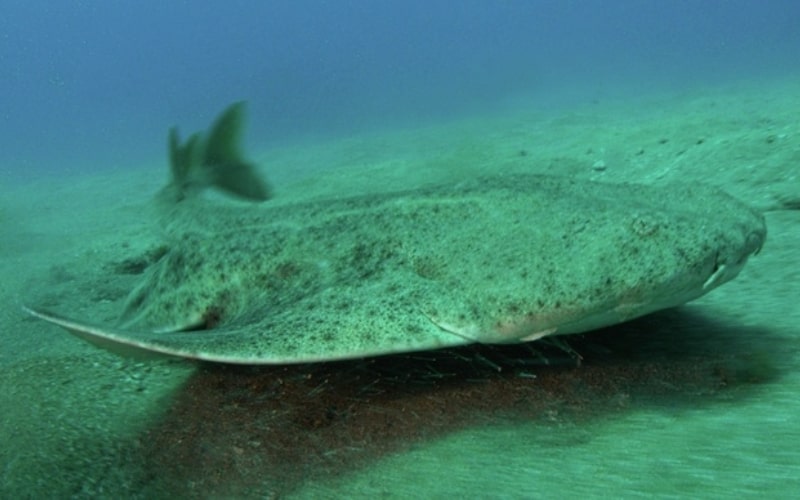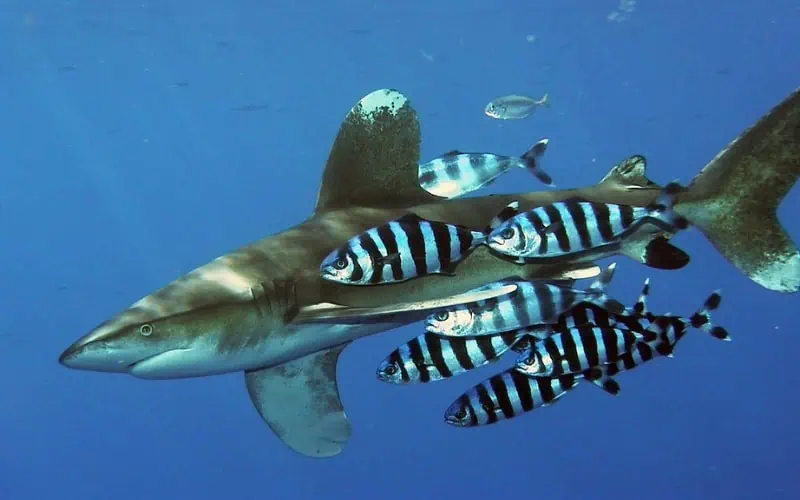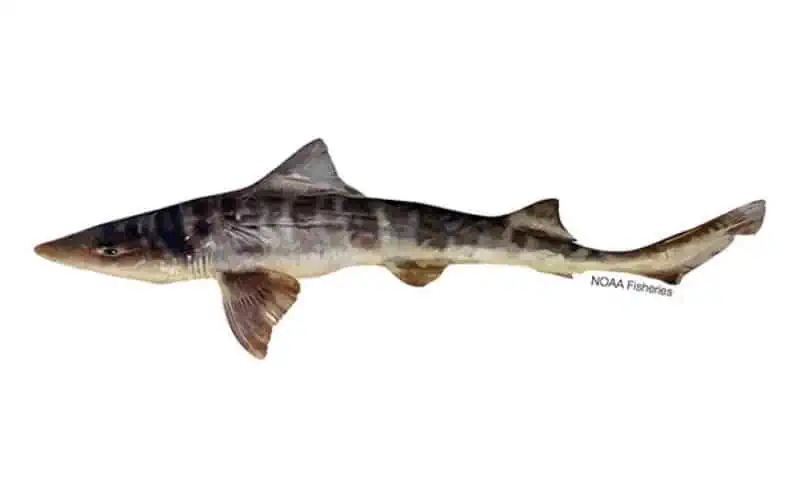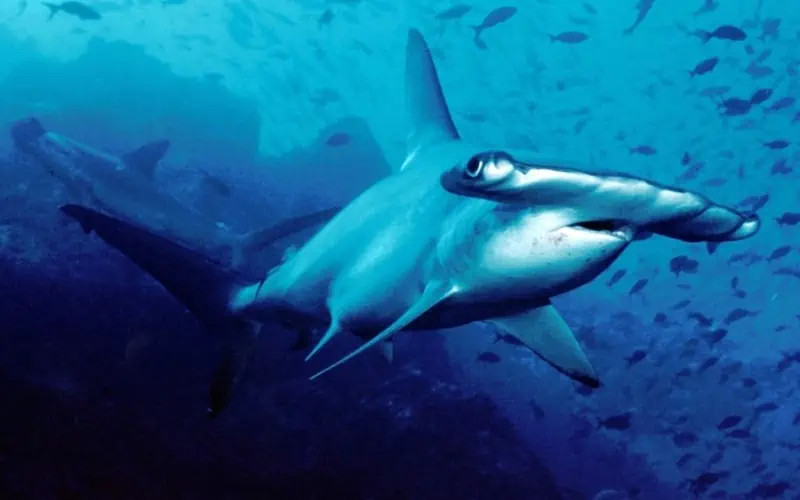Before dinosaurs walked the Earth, sharks dominated the planet’s oceans. In fact, sharks are so old that they predate trees! But many shark species are extinct, with others being so exceptionally rare that it’s unlikely you’ll ever spot them in the wild.
The rarest shark species is the Lost Shark (Carcharhinus obsolerus). There are only three known preserved specimens of this shark, the last of which was discovered more than eight decades ago. Consequently, the Lost Shark might be extinct, just like the prehistoric megalodon and xenacanthus.
Despite their reputation for being the ultimate predators of the sea, many shark species are highly endangered or potentially extinct. This ranking will reveal which sharks are the rarest of them all!
Here Are the Top 10 Rarest Shark Species on Earth:
- Lost Shark
- Borneo Shark
- Scalloped Hammerhead
- Ganges Shark
- Pondicherry Shark
- Daggernose Shark
- Sand Tiger Shark
- Striped Smooth-Hound
- Oceanic Whitetip Shark
- Angelshark
10. Angelshark

The angelshark (Squatina squatina) looks very different from other types of sharks, particularly the great white shark (Carcharodon carcharias). In fact, at first glance, you might mistake this shark for a ray or skate!
But, unfortunately, this shark’s relatively non-threatening appearance might be partially responsible for its rapid population decline. While this type of shark was once an extremely common sight in the waters around Europe and the United Kingdom, they’ve become far rarer over the last several decades.
Bigger, more aggressive sharks (like the great white) prey on the angelshark, and overfishing hasn’t helped matters. Currently, only a few thousand of these stingray-like fish live in the wild.
Why Is It So Rare?
The International Union for Conservation of Nature and Natural Resources (IUCN) classifies the angelshark as critically endangered due to its comparatively low wild population. Deep-sea fishing practices, primarily bottom trawling, are the main reasons this shark’s numbers have been on the decline.
The angelshark spends most of its time camouflaged on the ocean floor, preying on smaller fish that happen to come too close. Trawling boats scoop up unsuspecting angelsharks, and anglers may take too long to remove the sharks from nets to ensure that they safely return to the ocean.
9. Oceanic Whitetip Shark

While many types of sharks can cause a school of fish to scatter in a matter of moments, the oceanic whitetip shark (Carcharhinus longimanus) is rarely seen without a few smaller fish friends around. That said, it can spook schools of tuna and larger prey fish, as it’s not above engaging in the odd ravenous feeding frenzy!
Still, the oceanic whitetip shark has seen a steady and rapid population decline over the last 30 years. Their numbers have declined by up to 95% since the 1990s!
A significant portion of this decline is the result of human interaction. Although shark-based meals might not be a common treat for most in North America, shark fin soup remains a popular and traditional delicacy throughout Asia. The fins used for this soup often come from oceanic whitetip sharks.
Why Is It So Rare?
The oceanic whitetip shark is one of the most successful shark species. It’s instinctually curious and cautious, often “testing” potential prey before going in for the kill, and it’s also quite aggressive once provoked.
So, how did it become one of the rarest shark species?
Without a doubt, overfishing practices and the popularity of dishes like shark fin soup have made this species suddenly rare. Still, with the help of restrictive fishing laws, this shark might enjoy a population increase over time.
8. Striped Smooth-Hound

Like the angelshark, the striped smooth-hound shark (Mustelus fasciatus) probably isn’t what you picture when imagining a shark. Instead of being a massive hunk of silver-colored muscle with rows and rows of razor-sharp teeth, this shark is a slim multicolored fish with an average length of about 27 inches (70 centimeters).
Native to the cool coastal waters off the coast of Argentina and Brazil, this shark is quickly becoming far less common due to commercial fishing practices. If new legislation isn’t created to protect this species (or the laws aren’t enforced), the striped smooth-hound could go the way of the dodo bird!
Why Is It So Rare?
The primary reason why the striped smooth-hound shark is rare is overfishing. That said, a limited habitat might also play a role in this shark’s declining population.
Because the striped smooth-hound only lives in the waters along the eastern coast of South America, its natural habitat is quite small, especially when compared to the habitats of sharks that live in much deeper waters. Consequently, overfishing this shark is far easier.
7. Sand Tiger Shark

If you ever came eye-to-eye with a sand tiger shark (Carcharias taurus), your first instinct would probably be to panic. These large sharks have silvery squid-like eyes and a few rows of curved, wickedly sharp teeth, which tend to be on full display while the shark swims around.
But the chances of you running into one of these fearsome sharks is quite low. After all, there are likely fewer than 400 mature sand tiger sharks in the wild.
Besides, though these sharks might look quite intimidating, they don’t tend to attack humans. In fact, their mouths can’t open large enough to munch on unwary swimmers!
Why Is It So Rare?
Unfortunately, human activity is once again to blame for this shark’s declining population.
But unlike other types of sharks, many of which are purposely fished for their meat or fins, the sand tiger shark’s endangerment is mostly a side effect of general overfishing. As people continue to pull medium-sized prey fish from the ocean, the sand tiger shark’s available pool of prey shrinks smaller and smaller.
This dwindling supply of food, coupled with wayward nets along coastal areas, may force this shark’s population to even smaller numbers.
6. Daggernose Shark

Unlike the rarest and most expensive Betta fish, you wouldn’t be able to keep a daggernose shark (Isogomphodon oxyrhynchus) in a small glass bowl or standard-sized fish tank. That’s because the daggernose shark grows to about 5ft (approximately 1.5m) long!
But tank size issues probably wouldn’t be nearly as challenging to overcome as acquiring one of these fish. That’s because the daggernose shark is critically endangered. There are only about 250 of these sharks in the whole world.
Native to the coastal waters along the northern parts of South America, many daggernose sharks end up caught in trawling nets. Their natural habitat is expansive (several hundreds of miles of coastline), so the low population numbers could end up spelling doom for this species.
Why Is It So Rare?
Imagine that you lived a hundred miles away from the nearest person. Now imagine that that person also lived about a hundred miles away from anyone else. Would dating be easy?
Probably not.
For daggernose sharks, bottom trawling and commercial fishing have led to a significant population decline. And because of this decline, mature sharks struggle to find available mates and reproduce. For this reason, this species could end up becoming more scarce over the next decade.
5. Pondicherry Shark

The oceanic whitetip shark is so-called for its white-tipped fins, and the Pondicherry shark (Carcharhinus hemiodon) is essentially the yin to this larger shark’s yang. It has black-tipped fins, making it easy for anglers and seafaring folks to identify.
However, discovering one of these sharks is tricky. Fewer than 250 mature Pondicherry sharks are swimming around the waters near India, China, and Indonesia.
One of the most recent spottings occurred in 2011, but overfishing and waterborne pollution could put an end to this species.
Why Is It So Rare?
Even though the Pondicherry shark is more tolerant of freshwater than most other sharks, this evolutionary advantage might not save it from extinction. Overfishing has put a lot of pressure on this species, causing Pondicherry shark populations to drop drastically.
4. Ganges Shark

This shark gets its name from its native habitat, the Ganges river (which flows through India and Bangladesh). This river is one of the most crucial in the world due to its impact on human civilization, and many Hindus believe it’s sacred.
But the Ganges has become very controversial over the last few decades. Widespread pollution and water usage have altered this river in several negative ways, and the wildlife found in the Ganges has suffered accordingly.
One example is the Ganges shark (Glyphis gangeticus), the only freshwater-only shark in the world. This shark’s mature population is estimated at only about 240 individuals.
Why Is It So Rare?
Some sharks can live in brackish and saltwater environments, but only one thrives in freshwater-only habitats: the Ganges shark. But this shark is critically endangered because the Ganges has become so polluted and altered by human activity.
Fortunately, there is a silver lining in this story. As the Ganges continues to attract global attention from those hoping to revive it to its clean state, the chances that the Ganges shark might make a population rebound increase.
3. Scalloped Hammerhead

Hammerhead sharks are some of the most instantly-recognizable fish due to their iconic head shape. But have you ever heard of the scalloped hammerhead shark (Sphyrna lewini)?
This rare shark looks very similar to other hammerhead sharks, but it has little notches along the top of its head that differentiate it. It’s also considered exceptionally intelligent, with a larger-than-average brain size.
Still, the scalloped hammerhead’s intelligence hasn’t helped it avoid critical endangerment. It’s unknown how many of these sharks live in the wild, but numbers seem unusually low (likely 200 individuals or less).
Why Is It So Rare?
If you guessed that human activity is the primary reason behind this shark’s rarity, you guessed correctly. Many scalloped hammerhead sharks end up caught in coastal nets or trawling nets. These unfortunate fish are then butchered for their meat and fins.
It’s also worth mentioning that scalloped hammerhead sharks suffer from a high infant mortality rate. Anglers who target birthing grounds contribute to this low mortality rate.
2. Borneo Shark

Until 2004, the Borneo shark (Carcharhinus borneensis) was believed to be extinct. So, you can imagine how excited marine biologists were when they discovered this species was still swimming freely in the waters around Malaysia!
This slender shark might be the rarest type of requiem shark, though it’s far from the only endangered one. Like many of the world’s most expensive birds, the Borneo shark is critically endangered.
Only five of these sharks have ever been found (including those preserved about a century ago). Still, increased efforts to reduce fishing in the shark’s native habitat may lead to more Borneo shark sightings.
Why Is It So Rare?
Unsustainable fishing practices have made the Borneo shark a rare species. The Borneo shark is a coastal creature, making it easier for the average angler to catch.
Still, one type of shark is slightly rarer than the Borneo shark.
1. Lost Shark

The rarest shark species on Earth is called the Lost Shark (Carcharhinus obsolerus). Possibly extinct, this species is so rare that there are no photographs of live specimens, with only three preserved examples available for scientific study.
If this shark were extinct, it would be the first shark to go extinct since the dawn of man!
Sadly, little is known about the Lost Shark due to its extreme rarity. Additionally, the few preserved specimens of this shark were once mislabeled as unusual smalltail shark (Carcharhinus porosus) specimens. It’s only somewhat recently that zoologists and marine biologists realized that they were looking at a unique species.
Current estimates are that there a likely fewer than 50 of these sharks left alive, but the true total could be zero.
Why Is It So Rare?
It’s challenging to determine the precise reason why the Lost Shark is so rare. Several factors could’ve contributed to the decline of this shark’s population.
Some of the most likely causes include overfishing and breeding challenges, though environmental changes might also be to blame. After all, this shark is only native to the waters surrounding Borneo, Thailand, and Vietnam.
What’s the Rarest Shark in the World?
The rarest shark, the Lost Shark, might not even be around anymore! The most recent preserved specimen (and sighting) is more than 80 years old.
Consequently, not much is known about this mysterious requiem shark. However, only about 5% of Earth’s oceans have been explored, so there’s a chance that marine biologists might rediscover this shark at some point in the future.
Learn more about the world’s rarest and most expensive animals. Check out these related articles now!

